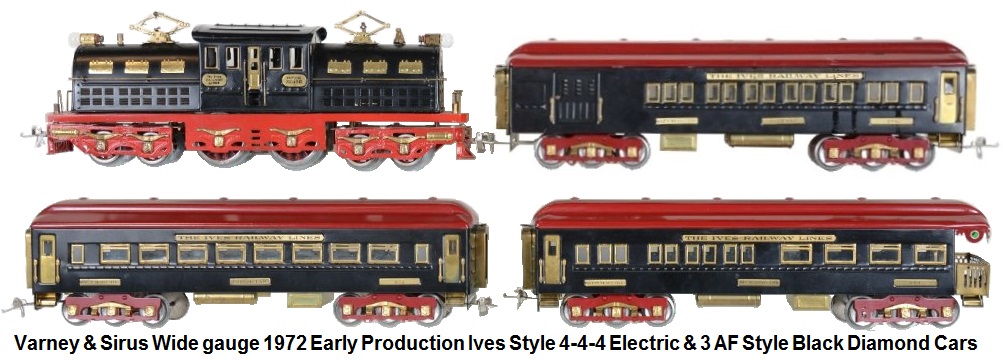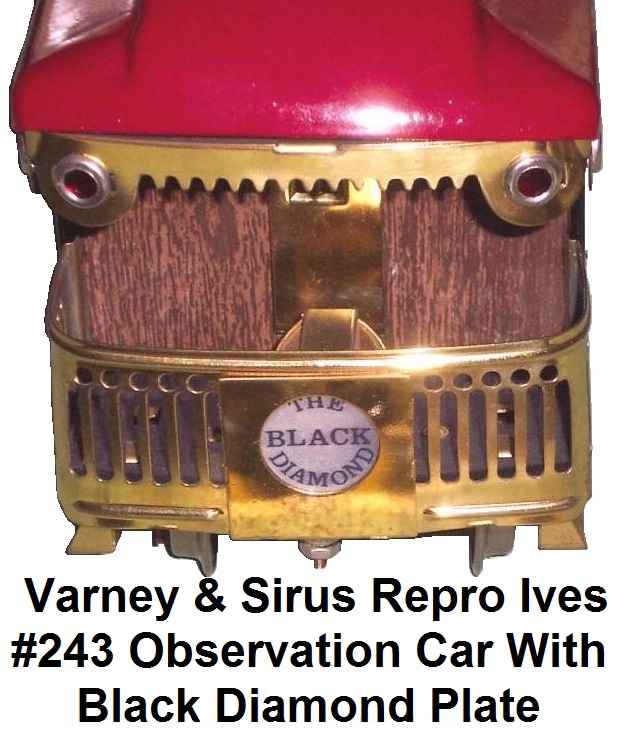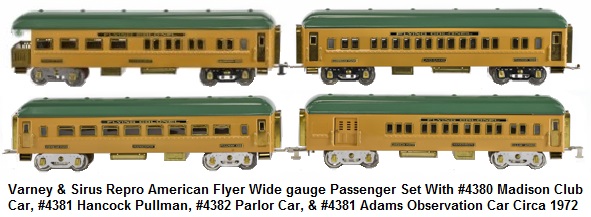 Arthur W. Varney and George A. Sirus formed a partnership to create reproduction trains and
copyrighted their creations in the early 1970's.
George A. Sirus actively collected tinplate American Flyer and Ives
Wide gauge beginning in the 1960's. He particularly liked the American Flyer nineteen inch President's Special type
coaches, which came in a series of different configurations and colors, and then moved into lves
transition sets. The transition era was a period when The Ives Company was first acquired by Amercan Flyer then
eventually by Lionel in the late 1920's and early 1930's. In the 1970's he partnered with Art Varney
and began to create these passenger cars and some locomotives as reproductions and sold them to
collectors as Varney & Sirus trains.
Arthur W. Varney and George A. Sirus formed a partnership to create reproduction trains and
copyrighted their creations in the early 1970's.
George A. Sirus actively collected tinplate American Flyer and Ives
Wide gauge beginning in the 1960's. He particularly liked the American Flyer nineteen inch President's Special type
coaches, which came in a series of different configurations and colors, and then moved into lves
transition sets. The transition era was a period when The Ives Company was first acquired by Amercan Flyer then
eventually by Lionel in the late 1920's and early 1930's. In the 1970's he partnered with Art Varney
and began to create these passenger cars and some locomotives as reproductions and sold them to
collectors as Varney & Sirus trains.
 Ives transition passenger cars used American Flyer bodies on Ives trucks and snake pull couplers. So it
was fairly easy to reproduce both the Ives and American Flyer coaches using a sigle set of dies. Varney &
Sirus reproductions are very good and are often mistaken for originals. There are a few ways to recognize
the difference. One way is to check the size of the rivet heads. On the Ives Prosperity cars, a quick
and easy way to spot the repros is by checking to see if the brass plates fit. On the Varney & Sirus
copies they don't fit correctly. Another way to recognize the copies is the platform from a Varney & Sirus
observation car has the name Black Diamond on the brass plate. The original cars never had any reference
to Black Diamond on them, as that was the catalog name. Besides the difference in the plates another
noticeable difference is that the windows may look crooked or not lined up correctly
on the reproductions. Another difference is the roof spreaders which hold the roof on. They're both on the
same side on the originals, but they are located on different sides on the reproductions as a result of
using the same die to stamp both sides. Varney & Sirus American Flyer cars that were painted in the
Pocahontas buff and green had Flying Colonel plates, while the original AF Pocahontas set did not.
Varney & Sirus AF style trucks did not flex properly, and as a result many of the cars did not run smoothly.
Owners have oftentimes rebuilt these trucks or replaced them completely
with original AF trucks. The Varney & Sirus pickup assemblies on the cars used red insulation material, while
the original Flyer pickups used a black colored insulation material.
Ives transition passenger cars used American Flyer bodies on Ives trucks and snake pull couplers. So it
was fairly easy to reproduce both the Ives and American Flyer coaches using a sigle set of dies. Varney &
Sirus reproductions are very good and are often mistaken for originals. There are a few ways to recognize
the difference. One way is to check the size of the rivet heads. On the Ives Prosperity cars, a quick
and easy way to spot the repros is by checking to see if the brass plates fit. On the Varney & Sirus
copies they don't fit correctly. Another way to recognize the copies is the platform from a Varney & Sirus
observation car has the name Black Diamond on the brass plate. The original cars never had any reference
to Black Diamond on them, as that was the catalog name. Besides the difference in the plates another
noticeable difference is that the windows may look crooked or not lined up correctly
on the reproductions. Another difference is the roof spreaders which hold the roof on. They're both on the
same side on the originals, but they are located on different sides on the reproductions as a result of
using the same die to stamp both sides. Varney & Sirus American Flyer cars that were painted in the
Pocahontas buff and green had Flying Colonel plates, while the original AF Pocahontas set did not.
Varney & Sirus AF style trucks did not flex properly, and as a result many of the cars did not run smoothly.
Owners have oftentimes rebuilt these trucks or replaced them completely
with original AF trucks. The Varney & Sirus pickup assemblies on the cars used red insulation material, while
the original Flyer pickups used a black colored insulation material.

In 1971 the Varney & Sirus replica of the American Flyer Wide gauge President's Special set was introduced.
The Mayflower set in chrome and brass was the top of the line. This was one of the most accurate replicas ever created of
this set. The cars are marked on the bottoms with the Varney & Sirus stamp for identification. The bodies and roofs
 were fashioned out of brass, not steel, and are therefore non-magnetic as were most of the known originals.
Many of the components of the Sirus & Varney repos were made with original American Flyer parts, such as
original battery boxes used for the passenger cars to conceal the light switches. Other parts were machined
and tooled by Dick Mayer of Rich-Art Manufacturing. Rich-Art later-on made
and sold its own versions of the Ives and American Flyer passenger coaches using the same dies. The
set included the #4689 Commander 4-4-4 electric outline locomotive, #4390 West Point Club Car, #4391
Academy Pullman, #4393 Annapolis Diner and #4392 Army-Navy Observation.
were fashioned out of brass, not steel, and are therefore non-magnetic as were most of the known originals.
Many of the components of the Sirus & Varney repos were made with original American Flyer parts, such as
original battery boxes used for the passenger cars to conceal the light switches. Other parts were machined
and tooled by Dick Mayer of Rich-Art Manufacturing. Rich-Art later-on made
and sold its own versions of the Ives and American Flyer passenger coaches using the same dies. The
set included the #4689 Commander 4-4-4 electric outline locomotive, #4390 West Point Club Car, #4391
Academy Pullman, #4393 Annapolis Diner and #4392 Army-Navy Observation.
In May of 1972 a copyright was filed for a 12 wheeled electric locomotive. Varney & Sirus then built their
reproduction Ives Olympian set. Varney & Sirus reproduction American Flyer passenger cars were labeled
Flying Colonel but were decorated in the Pocahontas paint scheme. The four cars include #4380 Madison club,
#4381 Hancock Pullman, #4382 Parlor and #4381 Adams observation cars.

At the 25th TCA Anniversary Convention held in Anaheim, California in June of 1979,
Lou Redman 'Mr. TCA' and George Sirus co-presented a gold-plated 50th Anniversary train set to
be auctioned at the TCA's 50th Anniversary Banquet in 2004. The set included Varney & Sirus reproductions.
George passed away on March 14, 2002, so he did not see his creation get auctioned at the 2004 convention. His
daughter Judy Sirus Anderson, her husband Dwayne Anderson, and the family have held on to his large collection
of trains as well as several antique automobiles including a 1933 Auburn Boat-tail Speedster and
a 1939 Jaguar SS100, among some others.
The well displayed collection is all Wide/Standard gauge American Flyer, Ives, and Lionel for the most part
in very good to excellent condition, with a separate section devoted to the Sirus & Varney reproduction cars.

